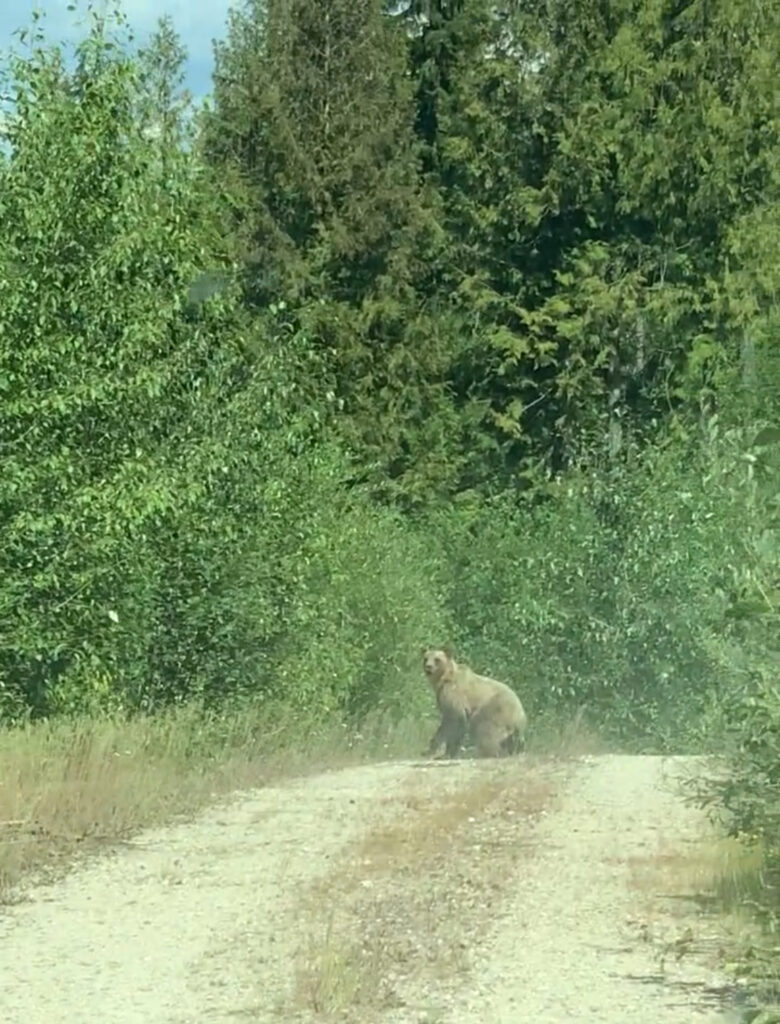Seeing bears is both exhilarating and slightly terrifying depending on where you see them. From your car: exhilarating, amazing, 10/10! But from the trail, it can be a little scary. So let’s talk about bear safety!
Entering bear country on hikes increases your chances of a bear encounter, like The Asulkan Valley Trail in Glacier National Park. Remember, you’re the stranger walking into their home. While bear encounters are relatively rare, it’s crucial to prepare yourself by learning to identify grizzly vs. black bears, minimize your chances of encounters, and react safely if do have an encounter and to always carry (and know how to use) bear deterrents.

Bear Safety Tip #1: Identifying Different Types of Bears
Before hiking in bear country, it’s imperative to familiarize yourself with the behaviour and characteristics of bears commonly encountered in the area. In North America, two main species of bears roam the wilderness here: grizzly bears and black bears.
Grizzly bears are typically larger and have a distinctive hump on their shoulders, while black bears have a straighter profile and lack this hump. Learning to differentiate between these species can help you assess the level of risk and determine the appropriate course of action in the event of an encounter.
Bear Safety Tip #2: Minimizing Your Chances of Encounters
While the prospect of encountering a bear may seem super daunting, don’t worry! There are several proactive measures you can take to minimize the likelihood of an encounter. Such as:
- Travelling in a group of 2+ people and staying close together
- Talking to your group members and if you see wildlife evidence on the trail (like fresh scat), talk loudly to alert the wildlife that your group is nearby
- Hike during daylight hours – avoid dawn, dusk and night hiking as this is when wildlife likes to be out and about
- Stay on designated trails
- Carry food in sealed bags or containers to minimize any yummy smells and pack out what you packed in.
Bear Safety Tip #3: Reacting Safely During an Encounter
Despite our best efforts to avoid them, bear encounters may still occur while hiking in bear country. If this happens, remember that it’s crucial to remain calm and avoid sudden movements that may startle or provoke the bear.
Assess the situation and determine the type of bear you’re encountering. If it’s a black bear, which is more common, stand your ground, raise your arms to appear larger, and make loud noises to intimidate the bear. In most cases, black bears will retreat when confronted assertively. However, if you encounter a grizzly bear, it’s essential to avoid direct eye contact, speak calmly, and slowly back away while keeping an eye on the bear.
Bear Safety Tip #4: Carrying and Safely Using Bear Deterrents
Always carry bear deterrents such as bear spray. Bear spray is a non-lethal deterrent that can effectively deter an aggressive bear at close range. When using bear spray, it’s essential to familiarize yourself with its proper use and practice deploying it quickly and accurately.
Carrying bear bells or other noise-making devices can also serve as a deterrent by alerting bears to your presence from a distance.
Bear Safety Tip #5: Hiking with Your Dog:
When you’re hiking with your dog in the backcountry it is important to understand that this can increase your chances of having a bear encounter.
To minimize these chances, follow the steps listed above as well as the following:
- Keep your dog on a non-retractable leash at all times. Leashes save lives!
- Attach a bell to your dog’s collar or harness to alert any wildlife in the area that you’re there.
- Carry bear spray or a bear air horn and know how to use them.
- Do not let your dog bark at, chase or corner a bear. It will end badly. Keep them leashed at all times.
Always prepare for any situation and carry bear spray in case you have a bear encounter. Check out BC Park’s deep dive on what to do if you have a bear encounter.
